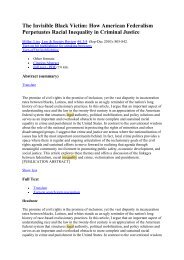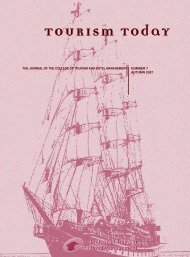Beyond the Qualitative Interview: Data Preparation and ... - E-Journal
Beyond the Qualitative Interview: Data Preparation and ... - E-Journal
Beyond the Qualitative Interview: Data Preparation and ... - E-Journal
Create successful ePaper yourself
Turn your PDF publications into a flip-book with our unique Google optimized e-Paper software.
National St<strong>and</strong>ards Institute text with line breaks to rich text format (RTF) or<br />
direct entry.<br />
Recently, we discovered Mergenthaler <strong>and</strong> Stinson’s (1992:129–30)<br />
seven principles for developing transcription rules. Some principles may be<br />
more applicable than o<strong>the</strong>rs, but <strong>the</strong>y appear to be consistent with <strong>the</strong> conventions<br />
established in our transcription protocol. The principles are as follows:<br />
1. Preserve <strong>the</strong> morphologic naturalness of transcription. Keep word forms, <strong>the</strong><br />
form of commentaries, <strong>and</strong> <strong>the</strong> use of punctuation as close as possible to<br />
speech presentation <strong>and</strong> consistent with what is typically acceptable in written<br />
text.<br />
2. Preserve <strong>the</strong> naturalness of <strong>the</strong> transcript structure. Keep text clearly structured<br />
by speech markers (i.e., like printed versions of plays or movie scripts).<br />
3. The transcript should be an exact reproduction. Generate a verbatim account.<br />
Do not prematurely reduce text.<br />
4. The transcription rules should be universal. Make transcripts suitable for<br />
both human/researcher <strong>and</strong> computer use.<br />
5. The transcription rules should be complete. Transcribers should require only<br />
<strong>the</strong>se rules to prepare transcripts. Everyday language competence ra<strong>the</strong>r than<br />
specific knowledge (e.g., linguistic <strong>the</strong>ories) should be required.<br />
6. The transcription rules should be independent. Transcription st<strong>and</strong>ards<br />
should be independent of transcribers as well as underst<strong>and</strong>able <strong>and</strong> applicable<br />
by researchers or third parties.<br />
7. The transcription rules should be intellectually elegant. Keep rules limited in<br />
number, simple, <strong>and</strong> easy to learn.<br />
DATA MANAGEMENT<br />
McLellan et al. / DATA PREPARATION 65<br />
Getting a H<strong>and</strong>le on Things<br />
When a qualitative research design involves <strong>the</strong> collection of audiotaped<br />
in-depth interviews or focus groups, researchers must decide whe<strong>the</strong>r <strong>the</strong>ir<br />
analysis is best supported by transcription or by researchers’ notes derived<br />
from or supplemented by a review of <strong>the</strong> audiotapes (Patton 2002:380–84).<br />
They must also take into account <strong>the</strong> cost, time, <strong>and</strong> expertise required to support<br />
ei<strong>the</strong>r decision.<br />
At some point, a researcher must also settle on what is transcribed. The<br />
phrase “settle on” has been deliberately selected because despite all best<br />
intentions, <strong>the</strong> textual data will never fully encompass all that takes place during<br />
an interview (Mishler 1986; Kvale 1996; Green, Franquiz, <strong>and</strong> Dixon<br />
1997; Pol<strong>and</strong> <strong>and</strong> Pederson 1998:294). Emerson, Fretz, <strong>and</strong> Shaw (1995:9)<br />
indicated that a transcript cannot ever produce a verbatim record of discourse,<br />
given <strong>the</strong> ongoing interpretive <strong>and</strong> analytical decisions that are made.














